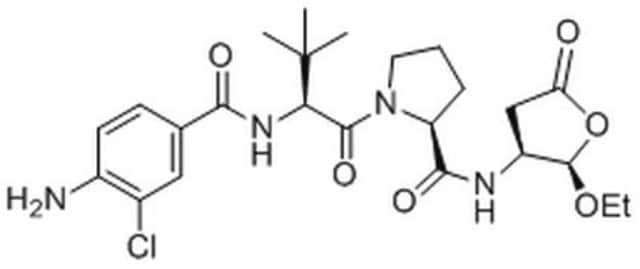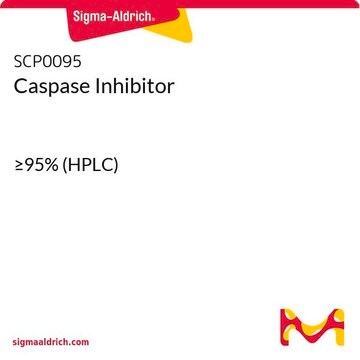C1230
Z-Ile-Glu(O-ME)-Thr-Asp(O-Me) fluoromethyl ketone
≥90% (TLC), powder
Sinónimos:
Z-IETD-FMK
About This Item
Productos recomendados
biological source
synthetic (organic)
Quality Level
assay
≥90% (TLC)
form
powder
solubility
methanol: 10 mg/mL
DMSO: 20 mM, clear, colorless to light yellow
shipped in
dry ice
storage temp.
−20°C
SMILES string
CC[C@H](C)[C@H](NC(=O)OCc1ccccc1)C(=O)N[C@@H](CCC(O)=O)C(=O)N[C@@H](C(C)O)C(=O)N[C@@H](CC(O)=O)C(=O)CF
InChI
1S/C28H39FN4O11/c1-4-15(2)23(33-28(43)44-14-17-8-6-5-7-9-17)26(41)30-18(10-11-21(36)37)25(40)32-24(16(3)34)27(42)31-19(12-22(38)39)20(35)13-29/h5-9,15-16,18-19,23-24,34H,4,10-14H2,1-3H3,(H,30,41)(H,31,42)(H,32,40)(H,33,43)(H,36,37)(H,38,39)/t15-,16+,18-,19-,23-,24-/m0/s1
InChI key
CTXDBLYOEUERAT-VUVYEONESA-N
Amino Acid Sequence
Application
- to study the activity of caspase-8 in porcine kidney cells
- to study its effects on porcine parvovirus (PPV)-induced caspase-3 activity in steroidogenic luteal cells
- to study its effects on retinal ganglion and astroglia in rat eyes
Biochem/physiol Actions
Features and Benefits
Storage Class
11 - Combustible Solids
wgk_germany
WGK 3
flash_point_f
Not applicable
flash_point_c
Not applicable
ppe
Eyeshields, Gloves, type N95 (US)
Certificados de análisis (COA)
Busque Certificados de análisis (COA) introduciendo el número de lote del producto. Los números de lote se encuentran en la etiqueta del producto después de las palabras «Lot» o «Batch»
¿Ya tiene este producto?
Encuentre la documentación para los productos que ha comprado recientemente en la Biblioteca de documentos.
Los clientes también vieron
Nuestro equipo de científicos tiene experiencia en todas las áreas de investigación: Ciencias de la vida, Ciencia de los materiales, Síntesis química, Cromatografía, Analítica y muchas otras.
Póngase en contacto con el Servicio técnico










